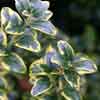| BUXUS
balearica I'm sure that traditional "Box" needs no introduction, save to explain why we have added it to our eclectic range. This is one seriously versatile plant! We all know it for hedging, topiary and pot culture, but I value it for its evergreen protection in a woodland setting. Very tolerant of dry conditions beneath trees, it will provide shelter for those precious woodland bulbs and early perennials. This species is different to the more commonly available sorts in that the rich dark green leaves are larger and the overall effect is to my eyes more architectural. So although it can be trained and pruned in all the ways associated with box, I enjoy the simplicity of this one when allowed to grow naturally. Once it has established and grown away (which it will do much more quickly than common box) it can be fun to remove the lowest side branches and inner twiggy bits and foliage to reveal its structure and attractive bark. This then creates a rather splendid dry and protected environment beneath it for bulbs that are often more vulnerable to the wetter British climate. Despite heralding from the Balearic Islands and Spain, this species has been superbly tolerant of our wet and exposed situation. Tiny white flowers in spring are the icy on the cake! |
|
|
|
|
 |
BUXUS sempervirens
'Elegantissima' The same principle as the species above, but with a little more colour to brighten a darker corner. B. sempervirens typically has smaller leaves than B. balearica described above, and this selection has neat gold margins to the leaves. |
|
|
|
| CALLICARPA
'Cardinal' Myriad tight clusters of tiny purple flowers are freely produced in the summer, but that's not why I grow this splendid shrub. I grow it for its autumn display, when the foliage slowly turns to the most amazing shades of red and purple. We have lots of wonderful autumn colours here, but this one is unique even amongst them. Small purple berries are scattered through them to complement the effect. This is the only Callicarpa that we currently grow, so pollination is entirely selfed, proving that it does not need a pollinator in order to produce fruit. The plant itself will grow quite happily in a shady site, but as is so often the case, the best autumn display will be produced in a sunny site. This is a compact grower, making a densely branched, rounded small shrub to around 1.5m in 10 years. |
|
|
|
|
| CALYCANTHUS
chinensis This plant is still extremely rare, having only been discovered in China relatively few years ago. It was previously classified within its own genus as Sinocalycanthus, recognising its relationship with Calycanthus. However, more recent research has concluded that it is not sufficiently different to be accorded generic status and thus it has now been sunk into Calycanthus. It first flowered in this country in 1989 in the garden of Roy Lancaster. Deciduous, and eventually reaching 2 or possibly 3m tall, it is very slow growing. It has large glossy green leaves which turn bright yellow in the autumn. These leaves are so large that the plant does best in a sheltered, shady site where the foliage can be more protected. The flowers are absolutely beautiful, being 7cm across and borne singly at the end of the shoots. The outer petals are pure white, with an inner group of yellow ones, white at the base with maroon markings. |
|
|
|
|
 |
CALYCANTHUS floridus "Carolina Allspice". As the name implies, this N. American native is wonderfully aromatic. Easily grown to form a dense medium sized thicketting shrub, it produces a mass of multi-petalled brownish-red flowers all summer, but also has rather nice autumn colour (photo left). |
|
|
|
.jpg) |
CALYCANTHUS
floridus 'Michael Lindsay' Another American clone, selected for reliable and profuse flowering as well as large and darker blooms. To put it simply - a superior selection! |
|
|
|
 |
CALYCANTHUS floridus var.
glauca 'Purpureus' This differs from the species by virtue of the larger purple-tinged foliage. |
|
|
|
| CALYCANTHUS 'Venus' | |
|
|
|
| CALYCANTHUS
x raulstonii 'Hartlage Wine' (Sinocalycanthus chinensis x Calycanthus floridus) This cross was made by a student at North Carolina State University in 1991, to flower in 1996. Giving the best of both parents, it produces masses of showy large, smoky wine-red flowers that open widely (almost like a camellia) with a subtle fragrance. It seems to be tolerant of most conditions, flowering equally profusely in sun or shade. It's a wonderful plant. See it in our Woodland Walk. |
|
|
|
|
| CARPINUS fangiana | |